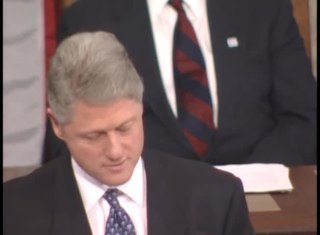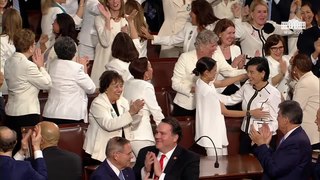
The State of the Union Address is an annual message delivered by the president of the United States to a joint session of the United States Congress near the beginning of most calendar years on the current condition of the nation. The State of the Union Address generally includes reports on the nation's budget, economy, news, agenda, progress, achievements and the president's priorities and legislative proposals.

Nancy Patricia Pelosi is an American politician who served as the 52nd speaker of the United States House of Representatives from 2007 to 2011 and again from 2019 to 2023. A member of the Democratic Party, she was the first woman elected as U.S. House Speaker and the first woman to lead a major political party in either chamber of Congress, leading the House Democrats from 2003 to 2023. A member of the House since 1987, Pelosi currently represents California's 11th congressional district, which includes most of San Francisco. She is the dean of California's congressional delegation.

The 2003 State of the Union Address was given by the 43rd president of the United States, George W. Bush, on January 28, 2003, at 9:00 p.m. EST, in the chamber of the United States House of Representatives to the 108th United States Congress. It was Bush's second State of the Union Address and his third speech to a joint session of the United States Congress. Presiding over this joint session was the House speaker, Dennis Hastert, accompanied by Dick Cheney, the vice president, in his capacity as the president of the Senate.

A joint session of the United States Congress is a gathering of members of the two chambers of the bicameral legislature of the federal government of the United States: the Senate and the House of Representatives. Joint sessions can be held on any special occasion, but are required to be held when the president delivers a State of the Union address, when they gather to count and certify the votes of the Electoral College as the presidential election, or when they convene on the occasion of a presidential inauguration. A joint meeting is a ceremonial or formal occasion and does not perform any legislative function, and no resolution is proposed nor vote taken.

The 2006 State of the Union Address was given by the 43rd president of the United States, George W. Bush, on January 31, 2006, at 9:00 p.m. EST, in the chamber of the United States House of Representatives to the 109th United States Congress. It was Bush's fifth State of the Union Address and his sixth speech to a joint session of the United States Congress. Presiding over this joint session was the House speaker, Dennis Hastert, accompanied by Dick Cheney, the vice president, in his capacity as the president of the Senate.

The 2005 State of the Union Address was given by the 43rd president of the United States, George W. Bush, on February 2, 2005, at 9:00 p.m. EST, in the chamber of the United States House of Representatives to the 109th United States Congress. It was Bush's fourth State of the Union Address and his fifth speech to a joint session of the United States Congress. Presiding over this joint session was the House speaker, Dennis Hastert, accompanied by Dick Cheney, the vice president, in his capacity as the president of the Senate.
The response to the 2006 State of the Union Address was delivered by Virginia Governor Tim Kaine on January 31, 2006, after United States President George W. Bush delivered his 2006 State of the Union address. The theme of Kaine's speech, "A Better Way", advocates the Democratic Party's policies and states' rights. Kaine delivered the speech from Virginia's historic Executive Mansion in Richmond and the speech was televised nationwide.

The 2004 State of the Union Address was given by the 43rd president of the United States, George W. Bush, on January 20, 2004, at 9:00 p.m. EST, in the chamber of the United States House of Representatives to the 108th United States Congress. It was Bush's third State of the Union Address and his fourth speech to a joint session of the United States Congress. Presiding over this joint session was the House speaker, Dennis Hastert, accompanied by Dick Cheney, the vice president, in his capacity as the president of the Senate.

The 2002 State of the Union Address was given by the 43rd president of the United States, George W. Bush, on January 29, 2002, at 9:00 p.m. EST, in the chamber of the United States House of Representatives to the 107th United States Congress. It was Bush's first State of the Union Address and his second speech to a joint session of the United States Congress. Presiding over this joint session was the House speaker, Dennis Hastert, accompanied by Dick Cheney, the vice president, in his capacity as the president of the Senate.

The 2008 State of the Union Address was given by the 43rd president of the United States, George W. Bush, on January 28, 2008, at 9:00 p.m. EST, in the chamber of the United States House of Representatives to the 110th United States Congress. It was Bush's seventh and final State of the Union Address and his eighth and final speech to a joint session of the United States Congress. Presiding over this joint session was the House speaker, Nancy Pelosi, accompanied by Dick Cheney, the vice president, in his capacity as the president of the Senate.

The 1995 State of the Union Address was given by the 42nd president of the United States, Bill Clinton, on January 24, 1995, at 9:00 p.m. EST, in the chamber of the United States House of Representatives to the 104th United States Congress. It was Clinton's second State of the Union Address and his third speech to a joint session of the United States Congress. Presiding over this joint session was the House speaker, Newt Gingrich, accompanied by Al Gore, the vice president, in his capacity as the president of the Senate.
The 1992 State of the Union Address was given by the 41st president of the United States, George H. W. Bush, on January 28, 1992, at 9:00 p.m. EST, in the chamber of the United States House of Representatives to the 102nd United States Congress. It was Bush's third and final State of the Union Address and his fourth and final speech to a joint session of the United States Congress. Presiding over this joint session was the House speaker, Tom Foley, accompanied by Dan Quayle, the vice president, in his capacity as the president of the Senate.

The 1988 State of the Union Address was given by the 40th president of the United States, Ronald Reagan, on January 25, 1988, at 9:00 p.m. EST, in the chamber of the United States House of Representatives to the 100th United States Congress. It was Reagan's seventh and final State of the Union Address and his eighth and final speech to a joint session of the United States Congress. Presiding over this joint session was the House speaker, Jim Wright, accompanied by George H. W. Bush, the vice president.

The 1990 State of the Union Address was given by the 41st president of the United States, George H. W. Bush, on January 31, 1990, at 9:00 p.m. EST, in the chamber of the United States House of Representatives to the 101st United States Congress. It was Bush's first State of the Union Address and his second speech to a joint session of the United States Congress. Presiding over this joint session was the House speaker, Tom Foley, accompanied by Dan Quayle, the vice president, in his capacity as the president of the Senate.

Barack Obama served as the 44th President of the United States from 2009 to 2017. Before his presidency, he served in the Illinois Senate (1997–2004) and the United States Senate (2005–2008).
The following is a timeline of the presidency of George W. Bush, from January 1, 2007, to December 31, 2007.

The 2019 State of the Union Address was given by the 45th president of the United States, Donald Trump, on February 5, 2019, at 9:00 p.m. EST, in the chamber of the United States House of Representatives to the 116th United States Congress. It was Trump's second State of the Union Address and his third speech to a joint session of the United States Congress. Presiding over this joint session was the House speaker, Nancy Pelosi, accompanied by Mike Pence, the vice president, in his capacity as the president of the Senate.

The 2020 State of the Union Address was given by the 45th president of the United States, Donald Trump, on February 4, 2020, at 9:00 p.m. EST, in the chamber of the United States House of Representatives to the 116th United States Congress. It was Trump's third and final State of the Union Address and his fourth and final speech to a joint session of the United States Congress. Presiding over this joint session was the House speaker, Nancy Pelosi, accompanied by Mike Pence, the vice president, in his capacity as the president of the Senate.

Joe Biden, the 46th president of the United States, addressed a joint session of the United States Congress on April 28, 2021, the eve of his 100th day in office. It was his first public address before a joint session. Similar to a State of the Union Address, it was delivered before the 117th United States Congress in the Chamber of the House of Representatives in the United States Capitol. Presiding over this joint session was the House speaker, Nancy Pelosi, accompanied by Kamala Harris, the vice president in her capacity as the president of the Senate—the first time two women and two Californians presided over an address to Congress, seated on the rostrum behind the president.

The 2022 State of the Union Address was given by the 46th president of the United States, Joe Biden, on March 1, 2022, at 9:00 p.m. EST, in the chamber of the United States House of Representatives to the 117th United States Congress. It was Biden's first State of the Union Address, and his second speech to a joint session of the United States Congress. Presiding over this joint session was the House speaker, Nancy Pelosi, accompanied by Kamala Harris, the vice president, in her capacity as the president of the Senate.




















